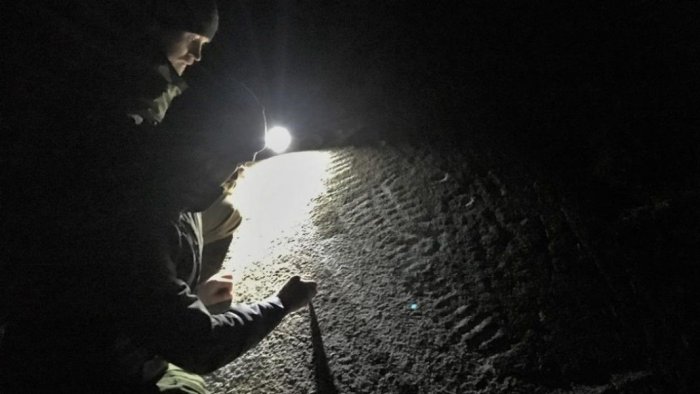Jan Bartek - AncientPages.com - Many rock carvings have been found in Østfold county, the landscape with the most petroglyphs in Norway, but do these ancient images contain hidden messages or were they merely prehistoric artistic expressions?
A group of dedicated archaeological explorers determined to break the code of these ancient petroglyphs can now offer interesting information about our ancestors.
Ships are among the most common motifs of Norwegian Bronze Age rock carvings. Credit: Science Norway
“We find new rock carvings almost every time we head out,” says Magnus Tangen, at The Norwegian Museum of Cultural History in Oslo, who along with his two friends Lars Ove Klavestad and Tormod Fjeld investigated several ancient sites.
Their recreational activities have already contributed to our knowledge about the people who lived in Norway in the Bronze Age 3000 years ago, according to a new article in ScienceNorway
Using photogrammetry, the three petroglyph hobbyists have combined the pursuit of ancient rock art with what many professionals believe may have led to a revolution in researching rock carvings.
It involves taking a variety of images from all angles and putting them together into 3D models. Computer programs can then show us aspects of the rock carvings we would otherwise never discover.
Today we know that the Bronze Age was a maritime culture where people in Norway actually had real ships like these that could travel long distances. So, it’s not surprising to learn many ancient carvings depict huge ships carrying people to the realm of the dead. Beliefs in the afterlife were widespread in Norway during the Bronze Age and later.
But who were the artists of these ancient petroglyphs and what were they trying to tell future generations?
Hunting for petroglyphs can lead to remarkable discoveries. Credit: Lars Ove Klavestad
“We now have stronger empirical evidence to claim that certain individuals or groups of people were responsible for carving several of the sites.
We can differentiate local forms of expression from each other, because with the help of the 3D models we can see that the artists had their own style,” he says.
The richness of detail we can get in the new pictures means that we can also tell which pictures at a petroglyph site were carved first and which ones were carved later. We can see how people came back and carved new figures on top of the old ones. This is really exciting,” Tangen says.
What Is The Petroglyph Code?
The archaeological team says their investigations showed there is a common pattern amongst the ancient petroglyphs and the keyword is – ocean.
“We started with the idea that the sea level in Østfold county in the Bronze Age – about 3000 years ago – must have been about 15-20 meters higher than it is today.
See also:
Sweden’s Tanum And Skredsvik Petroglyphs: Thousands Of Spectacular And Intriguing Rock Art
Tumlehed Rock Art And Seafaring In Stone Age’s Sweden
Spir Mountain Cairns: Prehistoric Ancient Monuments To The Dead In Northern Sweden
We took a map, followed the contour lines in the landscape and saw where the coastline must have been at that time. That’s how we discovered that the Østfold landscape must have been full of fjords and bays that went much further inland than they do now.
We also observed that most of the well-known petroglyphs were clearly located in exactly those kinds of places, well above today's sea level,” Tangen explains.
Tangen and his friends think most Bronze Age petroglyphs were carved by people who belonged to a maritime culture of fisherman-farmers and warriors.
These Were Not Farming Carvings
It has long been assumed the Norwegian petroglyphs from the Bronze were farming carvings, but name is misleading.
As Science Norway explains, “this name seemed obvious a hundred years ago, when lay people and scientists were finding these rock carvings in the agricultural landscape.
Here is the impressive ship the three found just a couple of weeks ago, enhanced with chalk. Credit: Lars Ove Klavestad
But today we have a greater understanding of how Norway’s land mass rose after the ice age. We know that the ocean once covered large parts of the lowest-lying parts of the country, especially in regions like Østfold.
The bulk of all rock carvings in Norway from the Bronze Age depict ships and boats. They offer a clear hint that these are pictures that have to do with the sea.
“About a thousand sites with rock carvings have been found around the Oslo Fjord. I would argue that 90 per cent of them are linked to the sea, lakes and fjords,” says Tangen.
Østfold county is of great interest to those interested in archaeology and ancient history. As we reported previously, some years ago Norwegian archaeologists made a fantastic discovery in the region. Using high-resolution georadar scientists unearthed a giant Vikings ship along with a Medieval settlement and 3 burial mounds. The ship is today known as the Gjellestad Viking ship.
The reconstruction of the Gjellestad Viking ship burial site. Credit: Gjellestadstory.no
A stunning virtual tour now gives the public a unique opportunity to admire the ancient settlement and look through the eyes of those who once lived there.
It wouldn’t be surprising to learn more interesting discoveries will be made in this region that is so rich in ancient history.
Written by Jan Bartek - AncientPages.com Staff Writer








